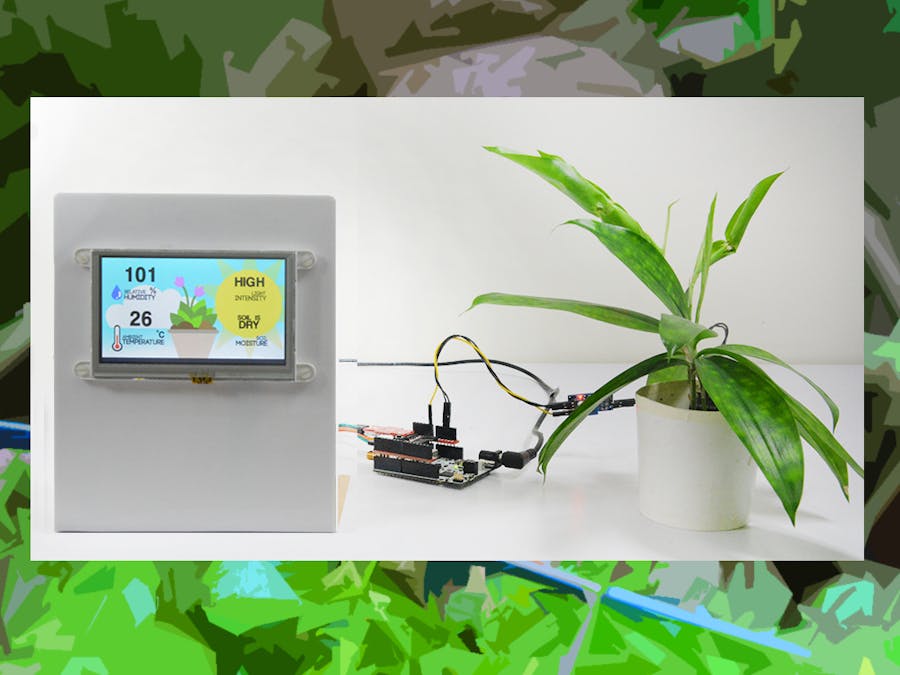The SmartEverything Plant Monitor project allows the users to build and create an all-in-one embedded monitoring system without the hassle and trouble of connecting too many sensors. The Arrow SmartEverything Development Board provides the essential sensors such as temperature, humidity, pressure and ambient light sensors to build a complete monitoring system.
gen4 HMI display is perfect for these kinds of embedded systems because it provides the graphical interface and communication between the user and the machine. In this project, we will be using fully customizable LED digit widgets and images to provide a personal touch to the project.
The project works by sampling data from the temperature, humidity and ambient light sensors on the SmartEverything Development Board and from the FC28 Hygrometer. A set of pre-defined values will be used to compare the actual sample to determine the status of the plant. Users can customize or change these values and connect an output device, such as water pumps or audible alarms that will be triggered when the comparison of data is satisfied.
How it Works- uUSB-PA5+ miniUSB cable or 4D programming cable
- FC28 Hygrometer with probe
- Flat flex cable
- gen4-IB
- 5-way cable
- uUSB cable
- 5V External Power Supply
- Open the Arduino IDE, then go to the Tools tab, select the Boards then the Boards Manager.
- On the drop-down menu box select “Arduino” and then choose the “Arduino SAMD Boards”, select the file and install.
- Then go back to the drop-down menu box, select “Partner” and choose the AMEL-Tech Boards”, select the file and install.
- Once the installation is complete, connect your SmartEverything development board and it should be detected the PC under the “Control Panel”.
- Go to Sketch and hover over the “Include Library” to select the “Manage Libraries” this will prompt a pop-up window.
- On the pop-up window, select the “Type” drop-down menu bar and select “Partner”
- Install all the necessary libraries related to the SmartEverything Board so you do not encounter any error or missing libraries.
The SmartEverything Libraries include:
- SmartEverything HTS221 by Seve - Library code for HTS221 Capacitive digital sensor for relative humidity and temperature.
- SmartEverything LPS25H by Seve - Library code for LPS25H MEMS pressure sensor
- SmartEverything LSM9DSI by Seve - Library code for LSM9DS1 iNemo intertial module.
- SmartEverything NFC NT3H1101 by Mik - Library code for NXP NT3H1101 a NFC_i2C Module
- SmartEverything SE868-AS by Seve - Library code for the Telit SE868-AS GPS System
- SmartEverthing SIGFOXLE51-868 by Mik - Library code for the TELEIT LE51-868 a SIGFOX Module
- SmartEverything VL6180X by Mik - Library code for the Ambient Light and Proximity sensor from ST component.
For more information regarding the SmartEverything Development Board, you can download the user manual using this link.
Loading the Graphics & CodesStep 1: BuildBuild the circuit as shown in the diagram. Please note that the SmartEverything Board built as a low-power device, which cannot power-up the gen4 HMI display alone. You must need an external power supply and follow the schematic diagram.
- Download the project file here.
- You can download Workshop 4 IDE and the complete code for this project from our website.
- Open the project using Workshop 4.
- You can modify the properties of each widget.
- Click on the Compile button.
Note: This step could be skipped. However, compiling is essential for debugging purposes.
Step 4: Comp’n Load- Connect the display to the PC using μUSB-PA5 and a mini USB cable. Make sure that you are connected to the right port. Red Button indicates that the device is not connected, Blue Button indicates that the device is connected to the right port.
- Now click on the “Comp’nLoad” button.
- Workshop 4 will prompt you to select a drive to copy the image files to a μSD Card. After selecting the correct drive, click OK.
- The module will prompt you to insert the uSD card.
- Properly unmount the μSD Card from the PC and insert it to the μSD Card slot of the display module. The image below must appear on your display after completing the steps above.
- Open the project using the Arduino IDE. Make sure you have already downloaded/installed/added the necessary drivers/tools/library for the SmartEverything Fox module by following the “Implementation (Using the SmartEverything dev board for the first time)
- Change and configure the settings on the “Tools”
- Select the correct Communication Port.
- Click on the “Upload” Button to compile, debug and load the code to the SmartEverything Fox module.
- If uploading is successful, you will encounter this message:
This indicates that ambient light is higher than the treshold, assuming sunlight and the soil moisture content is in the dry threshold. This will trigger the output device to turn ON.
This indicates that the project is placed in a much cooler and shadier place. The soil moisture content is back to normal and retaining a healthy water content for the plant.




















Comments
Please log in or sign up to comment.